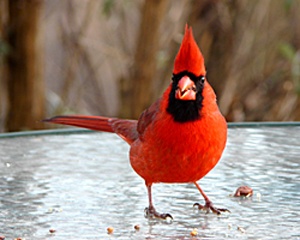We have much more to do and your continued support is needed now more than ever.
Valentine’s Day: A Holiday for Real Animals
Naturalist, writer and NWF Conservation Hall of Fame inductee Ernest Thompson Seton, whose animal tales were popular among a wide audience in the early 1900s, wrote in Wild Animals I Have Known, “Man has nothing that the animals have not at least a vestige of, the animals have nothing that man does not in some degree share.” Valentine’s Day, with its courtship rituals and mating games, stands out as one holiday that could prove his case. To wit:
Dressing Up

Consider the antlers of buck deer or bull elk or the mating plumage of male songbirds, ducks and peafowl. All of these points are important to attracting a mate, plus they can scare off competitors. Like a pricey power suit, bright plumage, antlers, bright spots on a bird’s bill or a lizard’s throat, say to potential mates, “Look at me and be awed. I’m strong and healthy enough to put energy into growing these doodads. I’m powerful and skilled.”
More generally, species-specific colors and appendages—a robin’s red breast, or a male mountain gorilla’s silver back—say, “Make no mistake about it, I’m a member of such and such gender, and I’m a dazzling example of our species, so what’s not to like?”
Individual members of many animal species learn from infancy that appearance is important. In fact, through a process called imprinting, individuals come to identify with the look of the creatures that raise them, which usually means their parents and ensures that they seek mates and companions from their own species. But you can take a newborn animal and mess with its head: Austrian zoologist Konrad Lorenz once raised a rook (a European member of the crow family) so that it became imprinted on him; as an adult the rook, interested in mating, tried to stuff worms into Lorenz’s ears as part of a (misdirected) courtship feeding ritual.
Bearing Gifts
Valentine’s Day is a prime gift-giving holiday, part merchandizing ploy and part courtship. But giving gifts to prospective or actual mates is not uniquely human.
Bonobo (a.k.a. pygmy chimpanzee) males sometimes offer fruit to females with which they want to mate. Many male spiders present dead insects to prospective mates, in part to keep the indiscriminately predatory females from eating the suitors. In some spider species, males wrap an insect gift in silk webbing so the female will be preoccupied with unwrapping it, further enhancing the males’ odds of escaping the mating process alive. (The males of at least one spider species give females just a wad of empty silk—ladies beware).
Some male birds are champion gift givers, offering complete nests to females. The bowerbird of Australia and New Guinea is a famed example, the male building elaborate nests decorated with small, often shiny objects that attract female attention. As with gaudy plumage, the nest tells females, “Hey, I’m a male in excellent physical condition, otherwise I wouldn’t be able to gather all these bits of bone, shell, fruit et cetera so I can offer you this delightful house with a rain-forest view.”
Among red-winged blackbirds, the males that lay claim to the best nesting sites get females first. In European storks, the legendary bearers of babies, the nest is a really potent gift. The birds mate for life, but their fidelity is to the nest, not the mate. Male and female return yearly to the same nest—not to each other—which has the effect of making them mates for life.
May I Have This Dance?

An obvious case is the peacock, with its outspread tail, which it will shake and rattle to attract females. Wild turkeys engage in the same ritual, with tom (male) turkeys spreading their brown tails like Puritan versions of peacocks. The expansion of body feathers as well as tail feathers makes males look larger and more fit, a display designed not only to attract females but to warn away other males.
Among the bird world’s real hoofers are the sage grouse and prairie chickens that gather on special dancing areas—flat, open grounds called leks—where they hop and stomp in a ritualized “dance” that attracts females. (Given that birds apparently descended from two-legged dinosaurs, one can only wonder if perhaps, millions of years ago, courting T. rexes capered about in thunderous, earth-shaking mating dances; probably not, but what an image!) In a real case of sharing, some American Indian peoples incorporated movements from prairie chicken mating dances into their own tribal steps.
Birds use other displays as well, such as eagles engaging in intricate mating flights, or male woodcocks spiraling into springtime skies as they issue mating calls. All show that the individual participants are fit, strong, agile—in all, a good potential mate.
Valentine’s Day: Wild about Red

Red, say biologists studying the color, is the shade of dominance and warning among nonhuman animals, too. In one study, rhesus macaques avoided people wearing red tee shirts and caps, but approached people in green or blue. Biologists have learned that red coloration on the faces and rumps of male mandrills—large African monkeys—gives them an advantage in attracting mates. Moreover, red plastic rings attached to the legs of male zebra finches increase their dominance.
So on Valentine’s Day, stick with tradition and go for the red.
Ernest Thompson Seton aside, there is a human behavior other animals are not known to share: the celebration of holidays. Happy Valentine’s Day! And may your courtship rituals prove true to your dreams.
To see more photos likes those in this blog, visit the National Wildlife Photo Contest site. You can celebrate your love for nature by entering the 42nd annual NWF National Wildlife Photo Contest, which opens Tuesday, February 14.
Read more about animals and birds from the pages of National Wildlife magazine.





















